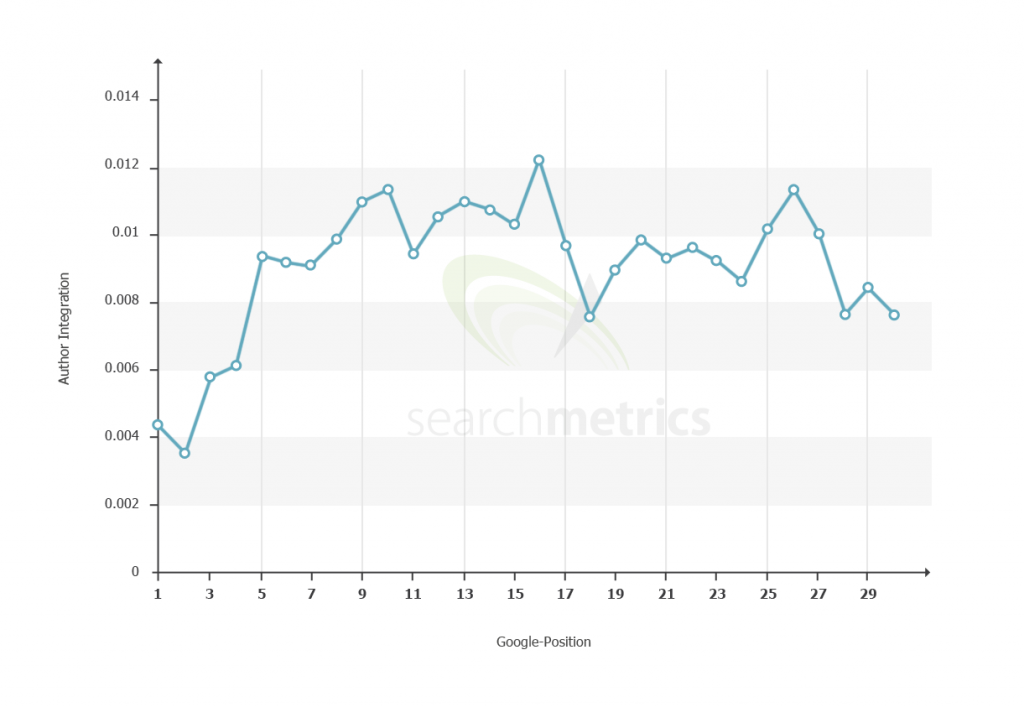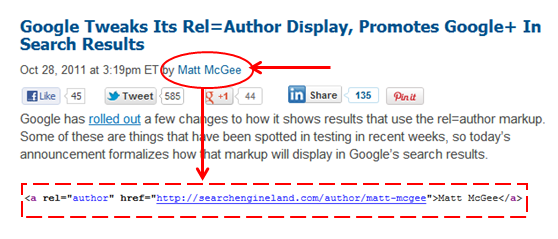In the world of search Google is king, and any changes to the algorithms that govern Google’s search results should be of top importance to content providers and marketers interested in maximizing the visibility of their work. For content writers that provide high-quality, in-depth articles on specific subject matter, the recent addition of Google Authorship has provided new avenues for content promotion.
Before continuing with this piece, you may want to read our recent blog post on Google Authorship, as it provides some additional context and important information.
Authorship allows content providers to link their Google+ account to articles that they post, which gives Google the access necessary to post short, detailed excerpts of their articles as a part of search results while showing the author’s name and headshot. In addition to providing obvious value to Google in the form of ever deepening control of the content space and additional access to information, the Authorship function allows article writers to better identify themselves while increasing the visibility of their work. A part of Google’s established goals is to end the “faceless web”, and Authorship is a significant step in that direction.
Recently one of the major conversations in the realm of search engine optimization has centered on Author Rank, a new feature connected to Authorship that will likely have a massive impact on the way that content is organized and presented by Google. While it’s currently somewhat unclear if Author Rank is actively impacting search results, it’s only a matter of time before the feature becomes a fully integrated part of the Google experience. In this article we’ll take a look at Author Rank and the impact it will likely have on the face of content on the web.
The Agent Rank Patent
In 2005, Google initially filed a patent for “Agent Rank,” which was re-filed in 2011. If this seems like an unconnected event, be aware that in this case “Agent” is being used as a synonym for “Author”. In most discussions of the topic going on today, Author Rank is being used as a replacement for Agent Rank.
The basic concept behind Agent Rank was simple: identify the author responsible for a given piece of content, and use that identity as another element of Google’s ranking algorithm. Authors would be assigned various “reputation scores,” and those with higher reputation scores would be ranked in a more prominent manner. This would potentially revolutionize the way that content is sorted, as authors that provided articles Google deemed of consistently high quality would be prioritized.
So, why didn’t Google roll out Agent Rank way back in 2005? Unfortunately for Google, the entire concept was reliant on the existence of a “digital signature” that would confirm who the author was and where the content came from. This would allow Google to connect the content with the author and assign an appropriate reputation score for the piece of content in question. At the time, there was no real practical way to provide a consistent signature for the number of agents, or authors, that Google would have to tag. Enter Google+, and the related Authorship function.
It’s Only A Matter Of Time
To think about it simply, Google was looking for a steady foundation to pin the Author Rank system to, and they found it in the form of Google+. The Authorship function allows authors to link their Google+ account to a given article, providing some immediate benefits for them in the way of improved identification and a profile picture placement next to the article in question. Google, in turn, gets a way to verify the real author of a given article, increasing transparency and encouraging the use of their social platform while providing an incentive for improved content quality.
Fundamentally, Google’s goal is to sort information in as useful a way as possible. That is the central service they offer, and any mechanism that can consistently improve the accuracy of the content that their customers are provided with represents significant value for them. Google Executive Chairman Eric Schmidt reinforced this by stating, “Within search results, information tied to verified online profiles will be ranked higher than content without such verification, which will result in most users naturally clicking on the top (verified) results.” As such, savvy members of the search community believe that it is only a matter of time before Author Rank is implemented.
Right now there’s not a strong connection between Author Rank and placement, but that will change in the future.
Author Rank is a powerful function that connects an additional data point, the reputation and overall value of the author in question, to the content being provided to Google’s users. It will likely have a significant impact on the way that search results are calculated, and individual authors and freelance writers would be wise to consider the below suggestions on how to best optimize their online presence to take advantage of Author Rank. But Google didn’t stop there; brands are also implicated by upcoming changes. Thus, leveling the playing field for upcoming freelance writers wanting to get their name out there without heavily relying on marketing teams.
Brand Rank – Rel=Publisher
The purpose of Authorship and Author Rank is clearly to highlight the people that produce content. This has clear applications for content writers, who should absolutely be excited by the changes. But what about ways for brands to get into the game and highlight their content?
This is going to get slightly technical, so bear with me for a moment. The way that authors use the Authorship function and establish a reliable two-way connection between their Google+ profiles and their content on the web is through the “rel=author” semantic markup. The first step is to link your website to your Google profile, and then go back and update your Google profile by adding a link back to your site.
A basic link looks like this:
<a href=”[profile_url]?rel=author”>Google</a>
See the rel=author tag? That’s the digital signature system Google relies on. Now we want to replace “profile url” with your actual Google+ profile information, which might look something like:
<a href=”https://plus.google.com/109412257237874861202?rel=author”>Google</a>
So what does this have to do with brands? Well, Google recently rolled out a separate tag called “rel=publisher” that looks strikingly similar.
They’re similar, but different. To be clear, these are different tags with different functions. The rel=publisher tag allows brands to connect their web sites to official Google+ brand pages. This lets Google post a small brand logo next to the content that originates from your brand in a manner similar to the Authorship function. It also allows Google to aggregate the +1s your content has received, potentially increasing your overall reach.
The similarity between the two tags has caused some to wonder whether Google will soon be rolling out a similar “Brand Rank” function that could have significant implications for brands. Even more so than with Author Rank, all conversations about Brand Rank are currently somewhat speculative in nature. That said, the recent steps that Google has made provide a strong indication that both features will eventually be rolled out, and that they may collectively change the face of content online.
Implications and Consequences
Author Rank and Brand Rank have significant implications for the way that content is sorted and prioritized through search results. Together, they’ll go a significant way towards ending the “faceless web” era by directly connecting content with content producer. Let’s take a look at the potential impacts of these two functions:
Author Rank will change content online by:
Increasing Transparency: Authors have long sought appropriate credit for their work, and the Authorship function is a significant step towards providing them with an appropriate level of recognition. The addition of a visual cue in the form of a profile picture is a significant eye-catcher, and opens up new possibilities for brand promotion.
Encouraging Social Media Integration: Authorship is fully integrated with Google+, and it’s likely that many of the metrics Author Rank uses to determine author reputation will be directly based on social use and behavior. This encourages additional social interaction and prioritizes authors that are active through Google+, giving Google another way to increase the importance of their social network.
Decreasing Plagiarism and Reworded Content: One of the largest ongoing struggles for content providers is the fight against plagiarism and reworded content. When an author spends the time and effort required to create a high-quality piece of content, it’s incredibly disheartening to see that content stolen and repurposed by ten different disreputable individuals. Author Rank and rel=author make it easier for Google to identify regular offenders and penalize them appropriately.
Penalizing Authors Who Aren’t Tech-Savvy: There’s a lot of potential value in Authorship and optimization of AuhorRank, but those benefits will never be realized by individuals who lack the technological savvy to properly optimize their online presence for these changes. By getting ahead of the curve and adopting early, it’s possible to gain a significant advantage in Author Rank over the competition.
Brand Rank will change content online by:
Improving Relevancy of Search Results: By allowing brands to tag their content and integrating content with brand identity, Google is better able to provide detailed, relevant content within search results.
Narrow Relevant Topics for Content: Through the BrandRank function, brands will likely be incentivized to provide a more narrow band of topics for their various types of content. When searching for a brands content Google will likely develop a basic understanding of their niche, and the types of content that have historically played the best with their audience. Focusing on these content types will maximize the searchability of brand content.
Increase the Visibility Hurdle for Startups: BrandRank is fundamentally about the development of a strong library of rich content and accumulating visibility and rank over time. Both of these elements are areas where startups are typically weak, as they simply haven’t had enough time in the business to accrue the necessary content library.
How To Prepare For Author Rank
Before entering into a deeper conversation on how to optimize your content for Author Rank, it’s important to keep in mind that this remains a theoretical discussion. Google hasn’t openly revealed the elements that will make up Author Rank and the service has yet to be fully implemented, so it’s left to us to infer the elements that an Author Rank and Brand Rank score might be based on.
That said, if you want to get ahead of the curve and improve your chances of visibility online it’s best to be prepared. Here are some simple ways for content authors and brands to optimize for the new ranking systems.
Writers:
Use the Rel=Author Function: This should be a no-brainer, but activating the Authorship feature and starting to tag your content is the first step towards building a good reputation score. If Google can’t identify you as the author of the content in question, it’s impossible for them to assign you an appropriate score or count that content as part of your library. There are many advantages to Authorship, so implement today and get started on building your score!
Build Google+ as a Promotional Tool: It’s in Google’s best interest to highly promote the use of Google+ as a central element of the Author Rank feature. Social signals like the rate of clicks, +1s, shares and so on for your content will likely be an important marker that Google uses, as will the overall traffic on your Google+ page. Take the time to optimize your Google+ profile for maximum visibility, and get involved with the various Google communities that could increase your prominence.
Narrow Your Focus: Due to the Authorship function, content authors will be more closely connected with their overall library of work. It’s likely that over time specific authors will become known for particular niche subject matter, and their audience will come to expect that work from them. While this is already the case to a degree, consider the impact of Authorship and Author Rank on this trend.
The Internet is increasingly moving towards niche providers of content that offer incredible insight into a particular topic, and improved searchability makes it less necessary for savvy consumers to rely on a generalist freelance writer. Consider producing more highly specific content to take advantage of increased search visibility.
Embrace High-Quality Content: The Authorship function and Author Rank is a clear statement by Google that they want to reward content writers who consistently produce high-quality content that delivers their users with clear value. Authors that produce the in-depth, content rich articles that Google loves will be rewarded, while those who rely on quick hits will likely be penalized. Embrace quality, and focus on building cornerstone articles you’ll be proud of!
Brands:
Implement Rel=Publisher: As with rel=author, rel=publisher is the underlying tag that allows Google to sort your content and give your brand appropriate credit for everything it does. If you haven’t already, set up a Google+ page for your brand at google.com/+/business/and spend the energy necessary to make that presence appealing to your market segment.
Write for Your Audience: It’s long been a belief by many brands that chasing the hot story is the way to go if you want to “piggyback” on a lot of web traffic. With the advent of BrandRank it’s likely that priority will increasingly be given to content directly relevant to your audience. This requires a more narrow focus, and emphasizes the development of content explicitly tailored for your specific audience.
Encourage Employees to Use Rel=Author and Boost Their Rank: Brands are made up of people, and it’s likely that one of the things that will boost your BrandRank is the cumulative rank of the people who author your content. Don’t be afraid to promote the people inside of your business, and encourage them to be active socially while helping them set up Author Rank. Your company blog can be a great place to highlight individual authors while building their credibility.










